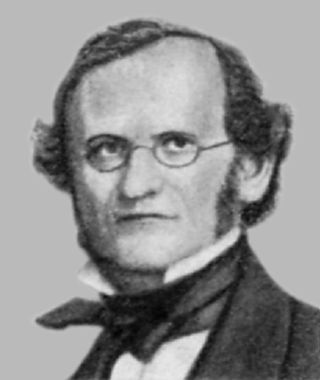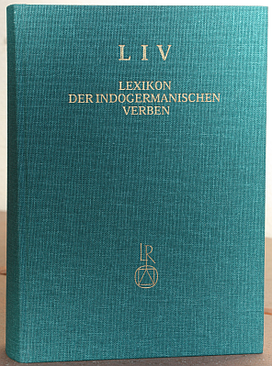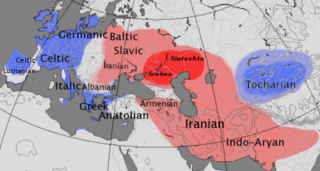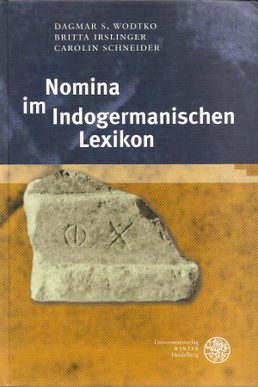
In linguistics, the comparative method is a technique for studying the development of languages by performing a feature-by-feature comparison of two or more languages with common descent from a shared ancestor and then extrapolating backwards to infer the properties of that ancestor. The comparative method may be contrasted with the method of internal reconstruction in which the internal development of a single language is inferred by the analysis of features within that language. Ordinarily, both methods are used together to reconstruct prehistoric phases of languages; to fill in gaps in the historical record of a language; to discover the development of phonological, morphological and other linguistic systems and to confirm or to refute hypothesised relationships between languages.
Verner's law describes a historical sound change in the Proto-Germanic language whereby consonants that would usually have been the voiceless fricatives *f, *þ, *s, *h, *hʷ, following an unstressed syllable, became the voiced fricatives *β, *ð, *z, *ɣ, *ɣʷ. The law was formulated by Karl Verner, and first published in 1877.

Franz Felix Adalbert Kuhn was a German philologist and folklorist.

Indo-European studies is a field of linguistics and an interdisciplinary field of study dealing with Indo-European languages, both current and extinct. The goal of those engaged in these studies is to amass information about the hypothetical proto-language from which all of these languages are descended, a language dubbed Proto-Indo-European (PIE), and its speakers, the Proto-Indo-Europeans, including their society and Proto-Indo-European mythology. The studies cover where the language originated and how it spread. This article also lists Indo-European scholars, centres, journals and book series.
Proto-Celtic, or Common Celtic, is the hypothetical ancestral proto-language of all known Celtic languages, and a descendant of Proto-Indo-European. It is not attested in writing but has been partly reconstructed through the comparative method. Proto-Celtic is generally thought to have been spoken between 1300 and 800 BC, after which it began to split into different languages. Proto-Celtic is often associated with the Urnfield culture and particularly with the Hallstatt culture. Celtic languages share common features with Italic languages that are not found in other branches of Indo-European, suggesting the possibility of an earlier Italo-Celtic linguistic unity.

Robert Stephen Paul Beekes was a Dutch linguist who was emeritus professor of Comparative Indo-European Linguistics at Leiden University and an author of many monographs on the Proto-Indo-European language.
Baltic mythology is the body of mythology of the Baltic peoples stemming from Baltic paganism and continuing after Christianization and into Baltic folklore.
Schleicher's fable is a text composed as a reconstructed version of the Proto-Indo-European (PIE) language, published by August Schleicher in 1868. Schleicher was the first scholar to compose a text in PIE. The fable is entitled Avis akvāsas ka. At later dates, various scholars have published revised versions of Schleicher's fable, as the idea of how PIE should be presented and pronounced has changed over time. The resulting parallel texts serve as an illustration of the significant changes that the reconstruction of the language has experienced during the last 150 years of scholarly efforts.
Historische Sprachforschung / Historical Linguistics is an annual peer-reviewed academic journal covering Indo-European historical linguistics. It is the second oldest linguistics journal still in publication. The current editors-in-chief are Martin Kümmel, Olav Hackstein, and Sabine Ziegler. The journal is published by Vandenhoeck & Ruprecht.

The Lexikon der indogermanischen Verben is an etymological dictionary of the Proto-Indo-European (PIE) verb. The first edition appeared in 1998, edited by Helmut Rix. A second edition followed in 2001. The book may be seen as an update to the verb entries of the Indogermanisches etymologisches Wörterbuch (IEW) by Julius Pokorny. It was the first dictionary fully utilizing the modern three-laryngeal theory with reconstructions of Indo-European verbal roots.
As the Proto-Indo-European language (PIE) broke up, its sound system diverged as well, as evidenced in various sound laws associated with the daughter Indo-European languages. Especially notable is the palatalization that produced the satem languages, along with the associated ruki sound law. Other notable changes include:
The numerals and derived numbers of the Proto-Indo-European language (PIE) have been reconstructed by modern linguists based on similarities found across all Indo-European languages. The following article lists and discusses their hypothesized forms.
The phonology of the Proto-Indo-European language (PIE) has been reconstructed by linguists, based on the similarities and differences among current and extinct Indo-European languages. Because PIE was not written, linguists must rely on the evidence of its earliest attested descendants, such as Hittite, Sanskrit, Ancient Greek, and Latin, to reconstruct its phonology.
The roots of the reconstructed Proto-Indo-European language (PIE) are basic parts of words to carry a lexical meaning, so-called morphemes. PIE roots usually have verbal meaning like "to eat" or "to run". Roots never occurred alone in the language. Complete inflected verbs, nouns, and adjectives were formed by adding further morphemes to a root and potentially changing the root's vowel in a process called ablaut.
Szemerényi's law is both a sound change and a synchronic phonological rule that operated during an early stage of the Proto-Indo-European language (PIE). Though its effects are evident in many reconstructed as well as attested forms, it did not operate in late PIE, having become morphologized. It is named for Hungarian-British linguist Oswald Szemerényi.
The nasal infix is a reconstructed nasal consonant or syllable *⟨n(é)⟩ that was inserted (infixed) into the stem or root of a word in the Proto-Indo-European language. It has reflexes in several ancient and modern Indo-European languages. It is one of the affixes that mark the present tense.

Languages of the Indo-European family are classified as either centum languages or satem languages according to how the dorsal consonants of the reconstructed Proto-Indo-European language (PIE) developed. An example of the different developments is provided by the words for "hundred" found in the early attested Indo-European languages. In centum languages, they typically began with a sound, but in satem languages, they often began with.
This glossary gives a general overview of the various sound laws that have been formulated by linguists for the various Indo-European languages. A concise description is given for each rule; more details are given in their articles.

Nomina im Indogermanischen Lexikon is an etymological dictionary of the Proto-Indo-European (PIE) nominals, that is, nouns and adjectives. It appeared in 2008, edited by German linguists Dagmar S. Wodtko, Britta Irslinger, and Carolin Schneider. Like other modern PIE dictionaries, NIL utilizes the modern three-laryngeal theory for its reconstructions.
Kleides or Klides or Klidhes or Kleidhes, meaning keys in Greek, is a group of small rocky uninhabited islands at the north of Cyprus. Some ancient writers called them the "edge of Cyprus" . Strabo writes that the Kleides were two isles lying off Cyprus opposite the eastern parts of the island, which are seven hundred stadia distant from the Pyramos river. Pliny the Elder, writes that they were four islands. In reality the islets are six, but the three can considered more like rocks in the sea than islets. The islands are also mentioned by the Ptolemy in his work Geography, Herodotus in his work Histories and Hesychius of Alexandria in his lexicon. A poem in Greek Anthology is also mentioning the islands.






